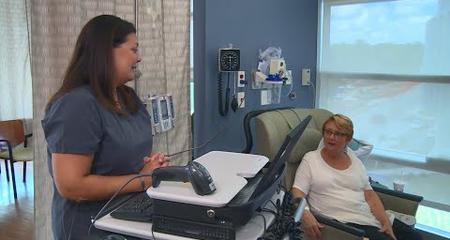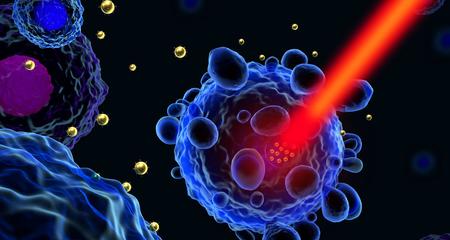As with medical oncology, Medical College of Wisconsin radiation oncologists are national leaders in developing clinical studies and standards of treatment related to the treatment of lung cancer. Radiation oncologists in the Thoracic Cancer Program have leadership roles in the National Cancer Institute’s sponsored research cooperatives and have specialized expertise and knowledge not readily found elsewhere.
The Radiation Oncology at Froedtert & the Medical College is accredited by the American College of Radiology (ACR). The accreditation is a rigorous process which provides impartial, third-party peer review according to the recognized standards of the scientific community.
Additionally, the department is credentialed for conventional and special radiation therapy procedures for treatment of lung cancer through National Cancer Institute sponsored Advanced Technology Consortium. This credentialing is required for quality assurance for treatment of patients on clinical studies sponsored by the NCI that use and evaluate Image Guided Radiation Therapy, TomoTherapy® Intensity Modulated Radiation Therapy), and Stereotactic Body Radiation Therapy. Credentialing ensures appropriate treatment on clinical trials and raises the standard of care for patients not treated on clinical trials.
Using Radiation Therapy to Treat Lung Cancer
The goal of radiation therapy is to treat the cancer while giving as little radiation to normal tissues as possible. Lung cancer is particularly challenging to treat due to the proximity of the tumor to critical tissues such as lung, airways, heart, major blood vessels, esophagus, and the spinal cord. Additionally, the tumor and normal tissues are in motion during treatment due to breathing. Several advanced radiation therapy delivery systems and techniques are available to effectively and safely deliver radiation.
- Stereotactic Body Radiation Therapy (SBRT): While small, localized lung cancer tumors are usually removed surgically, some patients are unable to have surgery because of the location of the tumor or other health conditions. For these patients, SBRT is one alternative. During each treatment, 10 to 15 small radiation beams converge on the tumor with pinpoint accuracy, delivering high doses of radiation to a tumor while sparing healthy tissue. SBRT reduces radiation treatment time from several weeks to just three to five treatments over one to two weeks.
- Image Guided Radiation Therapy (IGRT): IGRT involves daily imaging to make certain the patient is positioned correctly for treatment. If we are certain the patient is positioned within a small variation, we can have a smaller radiation field, which means potentially less toxicity and greater accuracy.
- TomoTherapy Intensity Modulated Radiation Therapy (IMRT): Froedtert & the Medical College of Wisconsin are among a limited number of centers using this advanced method of 3D CT scanning combined with radiation therapy.
- 4-D Imaging: The fourth dimension is motion. 4-D imaging is used for all radiation treatment planning to the chest. It provides the necessary information to adjust the radiation treatment for breathing motion. This can be accomplished with gated treatment delivery, breath hold and/or tumor tracking techniques. These techniques ensure the tumor is in the treatment field during all phases of the breathing cycle.
In the treatment of lung cancer, radiation may be used in many ways — as a primary treatment for cure, to shrink a tumor before surgery, to eliminate remaining cancer cells after surgery, and to control symptoms caused by lung cancer that has spread to other areas of the body. Radiation therapy may be given alone or combined with chemotherapy.
Personalizing Lung Cancer Treatment
Our team starts with national guidelines established by the National Comprehensive Cancer Network, and we are always aware of new and innovative approaches being studied, here and across the country. All of our treatments are based on solid science and expert consensus. We personalize the care to each patient’s needs.
- Small cell lung cancer (SCLC): The standard treatment approach for small cell lung cancer that has not spread is chemotherapy and radiation given at the same time. Typically, treatment is followed by re-staging and low dose radiation to the brain to prevent failure in the brain. More advanced stages of SCLC are generally treated with chemotherapy first and may be followed by radiation therapy to the chest and the brain and other sites of disease depending on the response to chemotherapy and symptoms.
- Non-small cell lung cancer (NSCLC): For early stage NSCLC patients who cannot tolerate surgery, there is stereotactic body radiation therapy (described above.) For patients with more advanced stages, the standard is radiation and chemotherapy. Some patients with marginally extensive disease may benefit from radiation and chemotherapy to shrink the tumor to make surgery a viable option.
Virtual Visits Are Available
Safe and convenient virtual visits by video let you get the care you need via a mobile device, tablet or computer wherever you are. We’ll gather your medical records for you and get our experts’ input so we can offer treatment options without an in-person visit. To schedule a virtual visit, call 1-866-680-0505.
More to Explore





